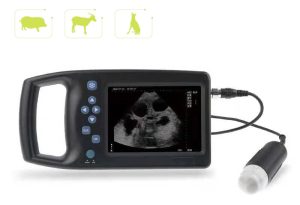Veterinary B-ultrasound transmitting and receiving circuit
The transmitting and receiving circuit of veterinary B-ultrasound is the key part of the pulse-echo ultrasonic diagnostic equipment, which has a great influence on the quality of the instrument. The emission of ultrasonic pulse is completed by the piezoelectric transducer, and its excitation energy is obtained from the high-voltage electric pulse provided by the high-voltage pulse generator.
In the veterinary B-ultrasound diagnostic equipment, except for some Doppler blood flow detection equipment, most of them use the same transducer for sending and receiving. The shared use of transceivers for veterinary B-ultrasound transducers reduces the cost of the transducer and simplifies the manufacturing process of the transducer; however, since the high-sensitivity receiving circuit must be connected with the high-power ultrasonic transmitting circuit, in order to avoid the receiving circuit being overvoltage In order to destroy the transmitting pulse, an isolation level must be added in the veterinary B-ultrasound receiving circuit.
After the signal passes through the isolation stage, it is processed by pre-amplification. The pre-amplifier circuit mainly completes the impedance transformation and makes the signal gain a certain dB, and the specific gain will be determined by the sensitivity and gain distribution of the whole machine. The basic requirements for the isolation level in the veterinary B-ultrasound receiving circuit are: any transmission pulse with a large amplitude cannot pass through, or the amplitude is limited to a small range; and the small echo signal is allowed to pass through almost without attenuation , so that the isolation level has no obvious impact on the sensitivity of the whole machine. The method of connecting two diodes in parallel at the receiving end should be used to limit the amplitude of the echo signal within a certain range.


